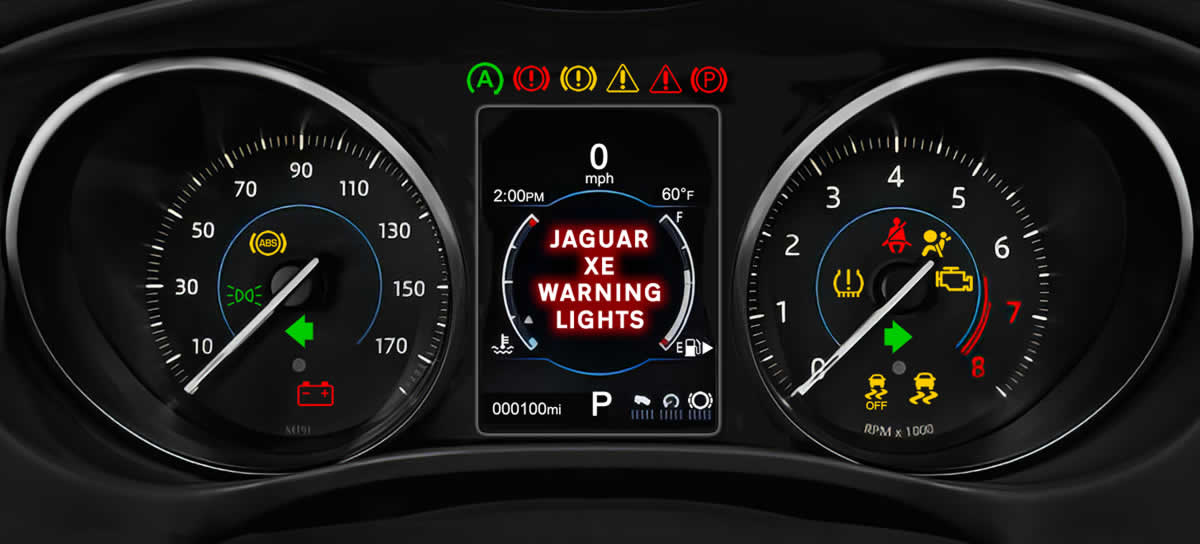Jaguar XE Dashboard Warning Lights
The Jaguar XE is a four-door saloon car manufactured by Jaguar Land Rover since 2015. The following warning lights offer a meaning to the symbols that may illuminate on the Jaguar XE instrument cluster. Dashboard design layout and warning light location may differ depending on the model location.
A warning lamp bulb check is initiated when the ignition system is switched on and lasts for 3 seconds (except for the airbag warning lamp which will remain on for 6 seconds). If any warning lamp remains on after this period, investigate the cause before driving.
Red warning lamps are for primary warnings. A primary warning must be investigated immediately. Amber and yellow warning lamps are for secondary warnings. Some indicate that a vehicle system is in operation, others indicate that the driver must take action. Green and blue lamps within the Instrument panel indicate system status.
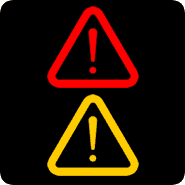 Warning Triangle
Warning Triangle
The Jaguar XE warning triangles containing an exclamation mark illuminate in red or yellow. The warning triangle are typically used where a dedicated warning light is not available and for messages. The severity of the warning depends on the colour of the triangle.
A red triangle illuminates when a critical warning message is available in the Message centre. A yellow triangle illuminates when a non-critical warning message or an information message is available in the Message centre.
Warning messages are displayed in order of importance. High importance warning messages are given the highest priority. Warning messages may be accompanied by an audible alert, and the message text may have the handbook symbol next to it. Warning messages are displayed until the condition causing the fault is rectified or the message is suppressed using the OK button on the steering wheel.
 Engine Temperature
Engine Temperature
The red engine temperature warning light will illuminate when the engine is too hot. If driving, pull over and switch off the engine when safe to do so. Allow sufficient time for the engine to cool before opening the bonnet.
A common cause is due to a lack of coolant. Check coolant levels. You can use water in emergencies, but flush the system and replace with correct coolant mixture. Check hoses for leaks. If coolant does not appear to be overheating, it may be a problem with the Jaguar’s thermostat. For further information, see red engine coolant warning light on or flashing.
 Low Oil Pressure
Low Oil Pressure
The low oil pressure warning light shouldn’t be confused with the low oil level light. However, low oil pressure can occur when engine oil levels are very low.
What Might Happen?
If the low engine oil pressure light comes on, due to low engine oil pressure, it means that the engine may not be sufficiently lubricated. Due to this, friction and heat will increase, potentially causing significant damage. If driving, pull off the road when safe to do so and switch off the engine immediately. Check oil levels, but only continue to drive if the warning light extinguishes.
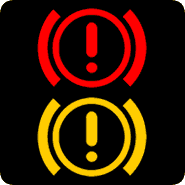 Brake System
Brake System
The Jaguar XE has two brake warning lights; one in red and another in yellow. If the red brake light illuminates while driving, suspect low brake fluid level or a fault with the Electronic Brake force Distribution (EBD) system. The EBD system allows for brake forces to be distributed to individual wheels, helping to improve the vehicle’s stopping ability. Stop the vehicle as soon as safety permits and check and top up the brake fluid. If brake levels are adequate, seek assistance as soon as possible.
If the yellow brake warning light comes on along with the message: ‘Brake Pads Worn’, it means that the vehicle’s brake pads are low and require replacing. If the yellow brake light illuminates without a message, then a fault has been detected with the brake wear system.
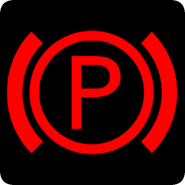 Parking Brake
Parking Brake
This red ‘P’ symbol illuminates when the Jaguar XE’s electric parking brake has been applied. If you’ve applied the electric parking brake and the symbol flashes, it means there’s a fault. The parking brakes may not be set.
Common problems with electronic parking brakes can be with the button itself. Over time, with continuous use, the button may fail. Other issues is that if the vehicle has not been used in some time, the caliper piston may be stuck, or the battery has low voltage.
 Charging System
Charging System
If there’s a fault with the Jaguar XE’s electric charging system, it’ll alert the driver by displaying a red battery light. The red battery light should only come on when the ignition is switched, but go off once the engine has started. If it stays lit, or comes on while you’re driving, a fault with the electric charging system has occurred. See why is my car battery warning light on for further information.
What Might Happen?
Depending on the vehicle’s electrical load, once the battery is exhausted of energy, the engine may stall. To reduce this risk, switch off any electrical systems that are not deemed essential. Then make your way to the nearest safe place to stop, of it a vehicle workshop is nearby, make your way there. Check the alternator, alternator belts and battery connections.
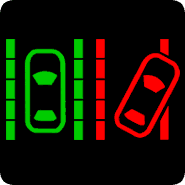 Lane Departure
Lane Departure
The Jaguar XE Lane departure warning system detects that the vehicle has crossed either of the lane markings that it is travelling within, without activation of the appropriate direction indicator, then the relevant lane will illuminate red.
This will also be accompanied by a vibration felt through the steering wheel. The green symbol illuminates to inform the driver that a lane line has been recognised.
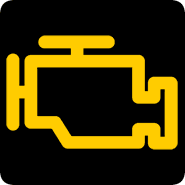 Engine / Transmission Fault
Engine / Transmission Fault
This light will illuminate when there’s a fault with the Jaguar XE engine or transmission. It also briefly illuminates when the ignition is switched on as a bulb check. If the light illuminates when the engine is running, there is an emissions related fault with the engine or transmission. The vehicle can be driven but may enter limp-home mode with the possibility of reduced performance. Limp-home mode is an override system designed to reduced damage.
There are many possible faults that cause the engine light to come on. To locate the fault, plug in a diagnostics scan tool into the vehicle’s OBD-II port. The scanner will search for fault codes. When the engine light comes on, a fault code is usually generated and stored. The scanner tool will then translate the code and provide you with more information on the fault. If the engine light flashes, have the vehicle checked right away as this can be an indication of an engine misfire. For further information, see reasons why the engine warning light is on.
 Glow Plugs Fault
Glow Plugs Fault
For diesel versions of the Jaguar XE, the glow plugs light illuminates when the ignition is switched on and goes off when the engine is ready to start.
A glow plug is essentially a heating element that heats fuel and air for combustion. If the glow plugs light comes on or flashes, it may mean the glow plugs require replacing. Diagnostics is usually recommended as the fault may not be related to the glow plugs directly.
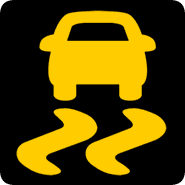 DSC
DSC
The Jaguar XE DSC (Dynamic Stability Control) system controls vehicle stability in critical driving situations. Additionally, it identifies unstable driving behaviour, such as understeer or oversteer, and helps to keep the vehicle under control by manipulating the engine power output and applying the brakes at individual wheels.
DSC also helps to reduce wheel spin via the traction control system. If wheel spin is detected, the system will intervene to control it by reducing engine power output and applying the brakes at individual wheels. This action will help to improve acceleration.
DSC is activated automatically when the ignition is switched on, but can be manually deactivated by pressing the DSC OFF button.
If there is a fault, it will remain illuminated and the Message centre will display DSC NOT AVAILABLE. The vehicle can still be driven, but without DSC assistance. A fault with the DSC system is often due to a damaged wheel speed sensor.
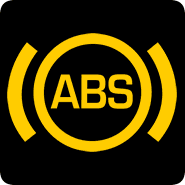 ABS
ABS
The Jaguar XE ABS (Anti-lock Braking System) is responsible for preventing the wheels from locking when under hard braking. The purpose being that the driver is still able to steer the vehicle due to the wheels not locking up. Almost all new cars now come with ABS as standard.
Having an ABS fault is reasonably common due to the system’s reliance on wheel speed sensors, one located at each wheel. The sensors are prone to damage and wear and can trigger an ABS fault. If the ABS light comes on, have a diagnostic scan, the most common cause is a malfunctioning wheel speed sensor.
 Airbag System
Airbag System
The Jaguar XE airbag Supplementary Restraint System (SRS) comprises of the following:
- Front passenger’s airbag.
- Front seat side airbag.
- Curtain airbags.
- Front seat side airbag.
- Driver’s airbag
- Safety Belts
If the airbag warning light remains lit after the initial bulb check, or comes on while driving, it may indicate a fault with any of the above. A diagnostic scan is usually required to search for fault codes. Common causes can relate to the airbag crash sensors, ABS module, airbag clock spring, or a cable becoming loose under the front seats.
 Adaptive Front Lighting
Adaptive Front Lighting
The Jaguar XE Adaptive Front-lighting System (AFS) optimises the distribution of light from the vehicle’s headlights. It does this on specific circumstances such as vehicle speed and steering input to improve visibility of the direction of travel.
If the AFS warning light illuminates, the headlights will continue to operate, but without the ability to optimise the distribution of light. Water or condensation within the headlight is the most common cause for adaptive headlight failure. This is due to the moisture which can damage the adaptive headlight module.
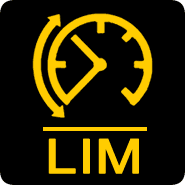 Automatic Speed Limiter
Automatic Speed Limiter
The Jaguar XE Automatic Speed Limiter (ASL) is available for the driver to set a maximum speed limit via controls on the steering wheel. If the speed limit has been exceeded, a warning light will display along with an appropriate message.
When ASL has been activated via the ASL button, a warning light will illuminate.
 Follow Mode
Follow Mode
The Jaguar XE Follow Mode is part if the vehicle’s Adaptive Cruise Control system. When in Follow Mode, the vehicle will maintain a constant time gap to the vehicle ahead until the vehicle ahead accelerates to a speed above the set speed or, the vehicle ahead moves out of lane or out of view or, a new gap distance is set. When Follow Mode is active, this warning light displays on the dashboard.
 Outside Temperature
Outside Temperature
The Jaguar XE outside temperature warning (snowflake warning light) comes on when temperatures approach freezing. The warning light serves to warn the driver that there might be frost or ice on the road surface and to drive with care. The outside temperature sensor is located under the left-side door mirror. For further information, see snowflake dashboard warning light explained.
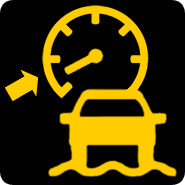 Progress Control System
Progress Control System
The Jaguar XE progress control system enhances the vehicle’s traction at low speeds, in either a forward or a reverse direction. Progress control helps to increase traction when pulling away, when ascending or descending a surface and in low traction situations such as driving in ice, snow, gravel, mud etc. This light illuminates when the progress control system is activated.
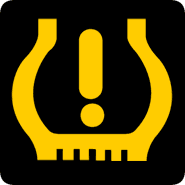 Tyre Pressure Monitoring System
Tyre Pressure Monitoring System
The Jaguar XE tyre pressure monitoring system (TPMS) constantly monitors individual tyre pressure via a tyre pressure sensor mounted inside each tyres valve. If the pressure of a tyre falls below the set values determined by the driver, the warning light illuminates. If there’s a fault with the TPMS, the warning light flashes for around a minute, then stays lit.
Always adjust tyre pressure when the tyres are cold. The recommended tyre pressures are listed on a label, located on the driver’s side B pillar. Open the driver’s door to access the tyre pressure label. If it is necessary to check tyre pressures when the tyres are warm, you should expect the pressures to have increased by up to 0.3 – 0.4 bar (4 – 6 psi, 30 – 40 kPa).
Common reasons for a TPMS fault can include:
- Using wheels or tyres that do not correspond to Jaguar’s recommendations.
- Fitting a tyre that does not contain a pressure sensor.
- Radio interference from internal or external sources.
- The battery in a pressure sensor has expired.
Resetting the TPMS
There is no need to manually reset the Jaguar XE tyre pressure monitoring system. After making any adjustments to the vehicle tyre pressures, drive the vehicle for at least 15 minutes in order to re-calibrate and reset the system.
 Intelligent Stop Start
Intelligent Stop Start
The Jaguar XE Intelligent Stop Start System is designed to improve fuel efficiency and is automatically activated when the ignition is switched on. When the engine has automatically been shut down, this green symbol illuminates on the dashboard.
The engine auto-stop system depend on various vehicle components and external variations. The Jaguar XE engine stop start may not work as expecting due to the following:
- An automatic transmission shift paddle has been used to select a gear.
- The external temperature is less than approximately 0°C (32°F).
- The external temperature is more than approximately 40°C (104°F).
- The engine has not reached operating temperature.
- The driver’s seat belt is not fastened.
- The Climate control system demand requires the engine to be running (for example, in Defrost mode).
- The battery’s charge is low.
- The bonnet is opened.
- Intelligent stop/start is deactivated.
In the event that engine stop start is unavailable, or if there’s a fault with the system, the message: ‘Auto Stop/Start Not Available’ is displayed.
 Gear Shift Indicator
Gear Shift Indicator
The green upward arrow with a plus sign is the gear shift indicator. It illuminate when the computer has determined that it’s economically a ideal time to shift up a gear.
The gear shift indicator will not illuminate when cruise control is active and is not being overridden by pressing the accelerator pedal.
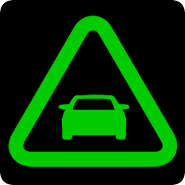 Forward Alert
Forward Alert
Forward alert provides limited detection and warning of objects close ahead while the vehicle is moving forwards. If a vehicle or object ahead is within the user defined sensitivity area, a warning tone will sound and the Forward Alert message will be displayed in the message centre. Emergency Brake Assist (EBA) will be activated. This green symbol illuminates when Forward Alert is activated.
 Cruise Control
Cruise Control
Cruise control is an electronic system that allows you to set your car to a specific speed, letting you take your foot off the accelerator pedal.
It can be operated by controls mounted on the steering wheel. The driver can also intervene at any time, by use of the brake or accelerator pedals.
